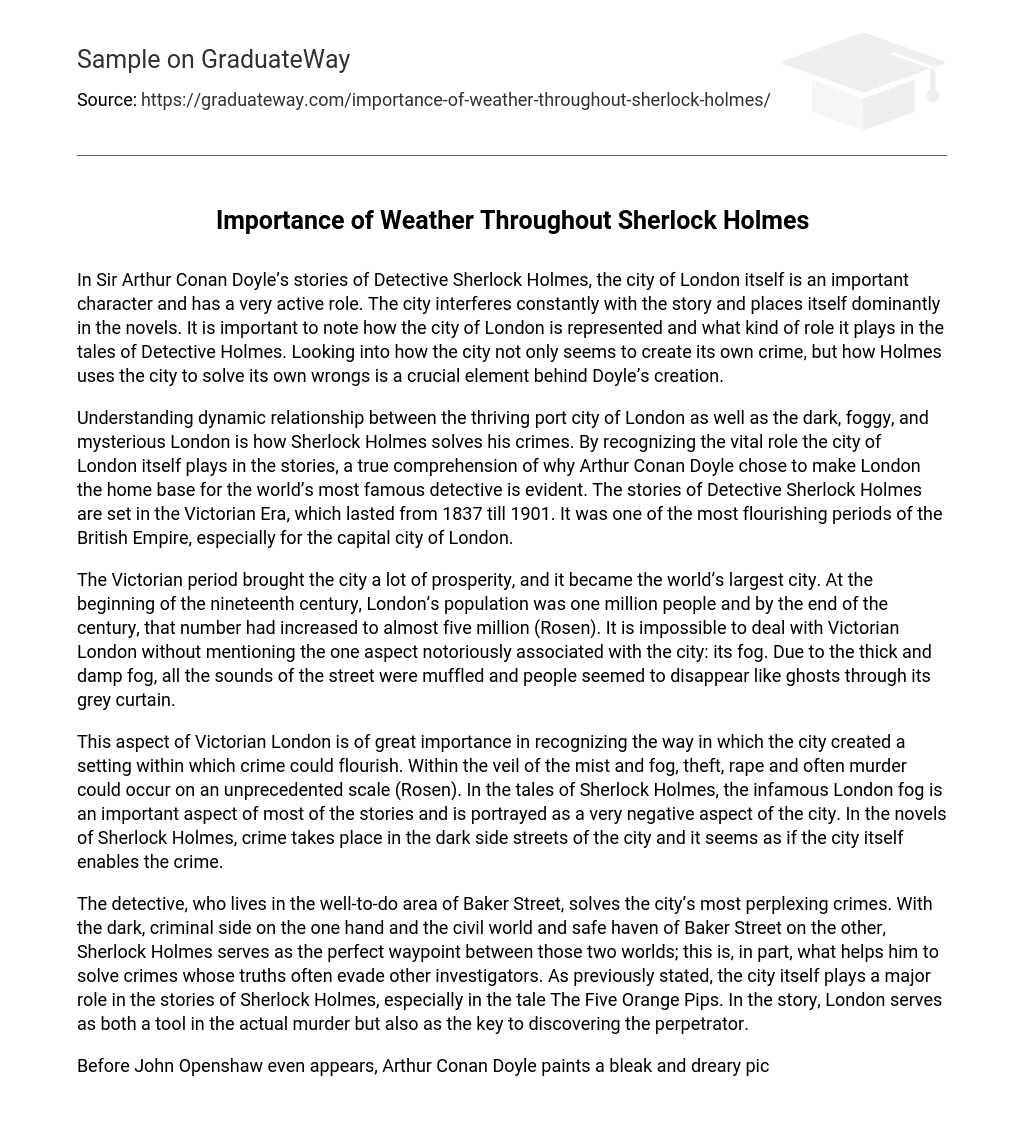In Sir Arthur Conan Doyle’s stories of Detective Sherlock Holmes, the city of London plays a significant role as an active character. It constantly interferes with the story, taking a dominant position in the novels. It is crucial to understand the representation of London and the role it plays in Holmes’ investigations. Examining how the city not only generates its own crimes but also serves as a means for Holmes to solve them is a fundamental aspect of Doyle’s creation.
In the Sherlock Holmes stories, London plays a significant role in shaping the narrative as the renowned detective solves crimes within its dynamic and mysterious aspects. Arthur Conan Doyle intentionally chose London as the setting for his famous character due to its importance during the Victorian Era (1837-1901), a prosperous period for both the British Empire and its capital city.
During the Victorian era, London experienced a period of prosperity that led to its becoming the largest city in the world. The population grew from one million at the beginning of the 19th century to almost five million by the end. One notable aspect of Victorian London was its fog, often mentioned as a prominent feature. This dense and damp haze muffled street sounds and created an eerie atmosphere where people seemed to disappear like ghosts within its grey blanket.
Victorian London’s mist and fog concealed a breeding ground for crime – theft, rape, and murder – on an unparalleled scale. This atmospheric feature plays a significant role in the tales of Sherlock Holmes, where it is depicted as a dismal aspect of the city. In these novels, crime unfolds in the shadowy alleyways of London, suggesting that the city itself facilitates its occurrence.
The detective, residing in the affluent area of Baker Street, unravels the city’s most perplexing crimes. Sherlock Holmes acts as a bridge between the city’s criminal underbelly and the civil sanctuary of Baker Street, aiding him in solving cases that often elude other investigators. As mentioned before, the city plays a significant role in Sherlock Holmes’ stories, particularly in The Five Orange Pips. In this tale, London serves as both a weapon in the actual murder and a vital clue in identifying the culprit.
The London weather in September was bleak and dreary, as the equinoctial gales raged with exceptional violence. The wind screamed and the rain beat against the windows, resembling untamed beasts in a cage. This ominous weather continued as John Openshaw discussed his troubles with Detective Holmes. After listening to all the necessary details, Holmes sent Openshaw to settle his affairs while he worked on the case.
As Openshaw departs, Watson likens his departure to the weather, describing it as being “blown in upon [them] like a sheet of sea-weed in a gale- and now to have been absorbed by it once more.” The following day, to Sherlock Holmes’ dismay, it is revealed that John Openshaw was killed while on his way to catch the train. According to the police report, the investigating officer presumed that due to the severe weather conditions that evening, Openshaw had stumbled in the darkness and fallen into the raging river, becoming nothing more than “the victim of an unfortunate accident.” In this manner, London’s weather becomes a vital component of the narrative as the murderers employ it to mask Openshaw’s death as an accident. However, Sherlock Holmes easily sees through this deception and uses the city itself to solve the crime. By correlating clues from the case with shipping log books containing information about the killer’s travels, deduced from postage stamps on Openshaw’s letters, Holmes unravels the puzzle. This allusion to London’s historical significance as a port city proves critical in cracking the case for Holmes as he utilizes minute details from the city to bring the murderer to justice.
The city of London in itself has a significant impact on The Five Orange Pips and other Sherlock Holmes stories by Arthur Conan Doyle. Holmes’s remarkable investigative abilities and his extensive knowledge of the city enabled him to draw extraordinary conclusions that others would overlook. In a sprawling metropolis like London, he had a keen eye for even the slightest details, unraveling truth and ensuring justice. It is this embodiment of London that makes Detective Sherlock Holmes’s tales so captivating, as it adds a new layer of enigma to the cases he solves.





